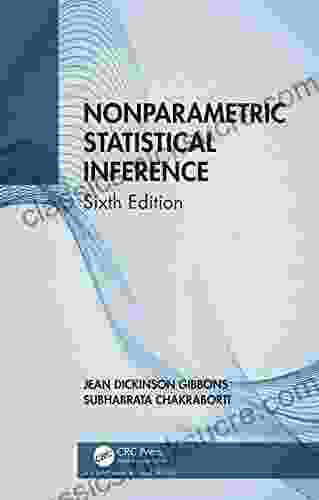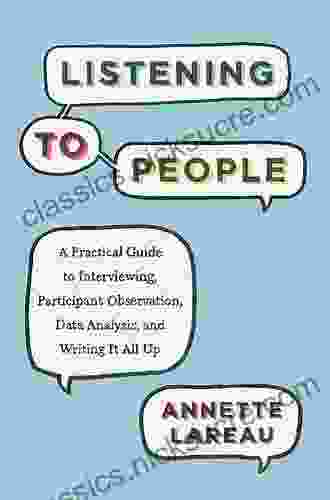Practical Guide to Interviewing, Participant Observation, and Data Analysis in Qualitative Research: Unlocking Insights and Drawing Meaningful Conclusions

Qualitative research methods such as interviewing and participant observation provide researchers with invaluable insights into the experiences, perspectives, and behaviors of individuals and groups. These methods allow researchers to capture the richness and complexity of human experiences and provide a deep understanding of social phenomena. However, analyzing qualitative data can be a challenging task, requiring careful consideration of methodological approaches and analytical techniques. This practical guide aims to provide a comprehensive overview of the processes involved in interviewing, participant observation, and data analysis in qualitative research.
Interviewing is a widely used qualitative method that involves conducting one-on-one or group-based discussions with participants to collect data. Interviews can be structured, semi-structured, or unstructured, depending on the research question and the level of researcher involvement.
- Structured interviews: Highly standardized interviews with pre-determined questions and response options, ensuring comparability across participants.
- Semi-structured interviews: Allow some flexibility in questioning while maintaining a general structure, providing both qualitative and quantitative data.
- Unstructured interviews: Open-ended discussions with minimal direction, allowing participants to share their perspectives and experiences freely.
- Establish rapport and build trust with participants.
- Use active listening skills and ask probing questions.
- Probe for details and encourage participants to elaborate.
- Record interviews accurately using audio or video recording (with consent).
- Transcribe interviews verbatim for thorough analysis.
Participant observation involves immersing the researcher in the natural setting of participants, allowing for direct observation of behaviors, interactions, and social contexts. The researcher can assume various roles, from passive observer to active participant.
4.7 out of 5
| Language | : | English |
| File size | : | 1083 KB |
| Text-to-Speech | : | Enabled |
| Screen Reader | : | Supported |
| Enhanced typesetting | : | Enabled |
| Word Wise | : | Enabled |
| Print length | : | 333 pages |
| Lending | : | Enabled |
- Complete observer: The researcher observes from a distance without interacting directly with participants.
- Participant as observer: The researcher observes while engaging in limited interactions with participants.
- Complete participant: The researcher fully participates in the social setting, but maintains an objective perspective.
- Gain access to the research setting and establish rapport with participants.
- Develop an observation protocol to guide observations and ensure consistency.
- Take detailed field notes, recording observations, behaviors, and interactions.
- Supplement observations with interviews and other data sources.
Qualitative data analysis is an iterative process that involves preparing, coding, interpreting, and theorizing the collected data.
- Transcribe interviews and organize field notes into a manageable format.
- Check for accuracy and identify themes and patterns emerging from the data.
- Assign meaningful codes to segments of data that represent key concepts and themes.
- Use inductive or deductive coding approaches, depending on the research question.
- Develop a coding scheme and ensure inter-coder reliability.
- Identify patterns and relationships within the data.
- Explore connections between different codes and categories.
- Develop interpretations and theories that account for the observed phenomena.
- Generate hypotheses and theories based on the interpretations made.
- Build a theoretical framework that explains the underlying mechanisms and processes.
- Discuss the implications and significance of the findings.
Various software tools can assist in the data analysis process:
- Qualitative Data Analysis Software (QDAS): NVivo, Atlas.ti, MAXQDA
- Text Analysis Software: AntConc, WordStat
- Statistical Software: SPSS, R
- Mind Mapping Software: MindNode, XMind
Conducting qualitative research requires adherence to ethical guidelines, including:
- Obtaining informed consent from participants.
- Maintaining confidentiality and anonymity.
- Respecting the privacy and rights of participants.
- Minimizing research bias and ensuring objectivity.
Interviewing, participant observation, and data analysis are fundamental techniques in qualitative research. By following the steps outlined in this guide, researchers can effectively collect, analyze, and interpret qualitative data to gain valuable insights into human experiences and social phenomena. Ethical considerations are paramount throughout the research process, ensuring the integrity and validity of the findings. With careful planning and methodological rigor, qualitative research can contribute to the advancement of knowledge and provide meaningful contributions to social science research.
4.7 out of 5
| Language | : | English |
| File size | : | 1083 KB |
| Text-to-Speech | : | Enabled |
| Screen Reader | : | Supported |
| Enhanced typesetting | : | Enabled |
| Word Wise | : | Enabled |
| Print length | : | 333 pages |
| Lending | : | Enabled |
Do you want to contribute by writing guest posts on this blog?
Please contact us and send us a resume of previous articles that you have written.
 Fiction
Fiction Non Fiction
Non Fiction Romance
Romance Mystery
Mystery Thriller
Thriller SciFi
SciFi Fantasy
Fantasy Horror
Horror Biography
Biography Selfhelp
Selfhelp Business
Business History
History Classics
Classics Poetry
Poetry Childrens
Childrens Young Adult
Young Adult Educational
Educational Cooking
Cooking Travel
Travel Lifestyle
Lifestyle Spirituality
Spirituality Health
Health Fitness
Fitness Technology
Technology Science
Science Arts
Arts Crafts
Crafts DIY
DIY Gardening
Gardening Petcare
Petcare Jessica Megan Larson
Jessica Megan Larson Kristina Kuzmic
Kristina Kuzmic Frank M Snowden
Frank M Snowden Gareth James
Gareth James Douglas Boze
Douglas Boze Peter C Earle
Peter C Earle Mjg Education
Mjg Education Jeffrey Rubin
Jeffrey Rubin Jim Meuninck
Jim Meuninck Jolene Stockman
Jolene Stockman Creek Stewart
Creek Stewart Steve Currier
Steve Currier Thema Bryant Davis
Thema Bryant Davis Olivia Seltzer
Olivia Seltzer Wilfred Cude
Wilfred Cude T Edward Nickens
T Edward Nickens Simon Gawesworth
Simon Gawesworth Anne Lamott
Anne Lamott Christopher Van Tilburg
Christopher Van Tilburg Jackie Bolen
Jackie Bolen Kimberly D Coleman
Kimberly D Coleman Tim Hill
Tim Hill Shirley Davis Brown
Shirley Davis Brown Stephen Rodrick
Stephen Rodrick Sarah Kowalski
Sarah Kowalski Micheal J Murphy
Micheal J Murphy Harvey Karp
Harvey Karp Jd Long
Jd Long Elia Kacapyr
Elia Kacapyr Annette Dixon
Annette Dixon John R Anderson
John R Anderson Kim Hutchinson
Kim Hutchinson Maria Del Mar Sacasa
Maria Del Mar Sacasa The Tutorverse
The Tutorverse Proper Education Group
Proper Education Group Julian Savulescu
Julian Savulescu New England Wild Flower Society
New England Wild Flower Society Tom Clynes
Tom Clynes Kay L Moody
Kay L Moody Phillip E Johnson
Phillip E Johnson Greg Jacobs
Greg Jacobs Monica Seles
Monica Seles Carl Nattrass
Carl Nattrass Martin Lees
Martin Lees Florence Littauer
Florence Littauer Paul Wilbur
Paul Wilbur Patty Bear
Patty Bear Marilynn Hughes
Marilynn Hughes John J Donohue
John J Donohue Abdi Nazemian
Abdi Nazemian Dean Karlan
Dean Karlan Fazale Rana
Fazale Rana Henry Treece
Henry Treece Eric Stice
Eric Stice Margaret L Lial
Margaret L Lial Magoosh
Magoosh Julie Kagawa
Julie Kagawa Joshua Piven
Joshua Piven Shyam Bharath S D
Shyam Bharath S D T K Richardson
T K Richardson Pedro J Izquierdo
Pedro J Izquierdo Anne Griffin Perry
Anne Griffin Perry Tomohito Oda
Tomohito Oda C Mo
C Mo Doug Knutson
Doug Knutson Johnson Smith
Johnson Smith Iain Campbell
Iain Campbell Jamie Davis
Jamie Davis Jeff Feldhahn
Jeff Feldhahn Aarron Davis
Aarron Davis Anthea Sharp
Anthea Sharp Josh Alwine
Josh Alwine Jack Petrash
Jack Petrash Ralph Henry Barbour
Ralph Henry Barbour Dan John
Dan John David Cayley
David Cayley Thomas Celentano
Thomas Celentano Jak Beardsworth
Jak Beardsworth Shea Serrano
Shea Serrano R Michael Shaft
R Michael Shaft Brian J Sorrells
Brian J Sorrells Matt Bronsil
Matt Bronsil Anne Laure Jackson
Anne Laure Jackson Helena Hjalmarsson
Helena Hjalmarsson Srinivasan S Pillay
Srinivasan S Pillay David Hoffbrand
David Hoffbrand Phil Richards
Phil Richards Matilda Joslyn Gage
Matilda Joslyn Gage Kindle Edition
Kindle Edition Joshua M Powell
Joshua M Powell M J Ryan
M J Ryan Marie Lu
Marie Lu Laura Warren Hill
Laura Warren Hill Michael Higgins
Michael Higgins Giovanni Bennardo
Giovanni Bennardo Filipe Masetti Leite
Filipe Masetti Leite Mamma Margaret
Mamma Margaret Lavinia Spalding
Lavinia Spalding Al Beatty
Al Beatty Anne Crossman
Anne Crossman Raye Wagner
Raye Wagner Anne Mctiernan
Anne Mctiernan Charles L Byrne
Charles L Byrne Kristen Welch
Kristen Welch Susan Ee
Susan Ee Janet Lansbury
Janet Lansbury Douglas R Dechow
Douglas R Dechow Michelle Obama
Michelle Obama Kevin Keitoshi Casey
Kevin Keitoshi Casey Laurence Parent
Laurence Parent Zenas Leonard
Zenas Leonard Peter Walker
Peter Walker Jack Thurston
Jack Thurston Claire Fraise
Claire Fraise David Mcgowan
David Mcgowan Ted Leeson
Ted Leeson Victoria Biggs
Victoria Biggs Richmond Campbell
Richmond Campbell Paul J Zak
Paul J Zak Cylin Busby
Cylin Busby Marcia Nathai Balkissoon
Marcia Nathai Balkissoon Bill Plotkin
Bill Plotkin Sabrina Sargent
Sabrina Sargent Kris Hampton
Kris Hampton Harlan Cohen
Harlan Cohen Susan Dexter
Susan Dexter Annie Thoms
Annie Thoms Michael A Stackpole
Michael A Stackpole Kevin Fall
Kevin Fall Zoeunlimited
Zoeunlimited William A Richards
William A Richards Katie Hewett
Katie Hewett Christopher F Chabris
Christopher F Chabris Jacob Erez
Jacob Erez Julie Hall
Julie Hall Robert Kaplinsky
Robert Kaplinsky Dr Deirdre Clark
Dr Deirdre Clark Steven M Rice
Steven M Rice Jean Liedloff
Jean Liedloff Lorraine Evans
Lorraine Evans C G Yeager
C G Yeager Lisa Delmedico Harris
Lisa Delmedico Harris Babette A Brumback
Babette A Brumback Jack Challoner
Jack Challoner Kj Dell Antonia
Kj Dell Antonia Kathryn Cadenhead Colgrove
Kathryn Cadenhead Colgrove Caroline D Greene
Caroline D Greene Kelly St Clare
Kelly St Clare Vincent J Monastra
Vincent J Monastra David Shoemaker
David Shoemaker John Snygg
John Snygg Don Cherry
Don Cherry Stan Byrdy
Stan Byrdy Herbert Dorsey
Herbert Dorsey Ed Van Put
Ed Van Put Paul H Wender
Paul H Wender Bryan Greetham
Bryan Greetham David Sheff
David Sheff Teri Halstead Rn Msn
Teri Halstead Rn Msn Jaron Lanier
Jaron Lanier Merlisa Lawrence Corbett
Merlisa Lawrence Corbett Dave Bosanko
Dave Bosanko Sasha Sagan
Sasha Sagan Chris Creamer
Chris Creamer John Allen Paulos
John Allen Paulos Jean Markale
Jean Markale Luke Amadeus Ranieri
Luke Amadeus Ranieri Karen Simmers Nartker
Karen Simmers Nartker Peter Lipton
Peter Lipton Md Nazaneen Homaifar
Md Nazaneen Homaifar Francis French
Francis French Michael Volkmar
Michael Volkmar Kate Jones
Kate Jones Steve Mchugh
Steve Mchugh Robert Weintraub
Robert Weintraub Hiro Fujiwara
Hiro Fujiwara Critical Role
Critical Role L J Smith
L J Smith Anne Winkler Morey
Anne Winkler Morey Joel Gunderson
Joel Gunderson Kass Morgan
Kass Morgan Anne Garrels
Anne Garrels Bradley Wiggins
Bradley Wiggins Jerry A Pattengale
Jerry A Pattengale Michelle Mullen
Michelle Mullen Annie Murphy Paul
Annie Murphy Paul Lynn Painter
Lynn Painter Notesbo Funny
Notesbo Funny Justin J Lehmiller
Justin J Lehmiller Russ King
Russ King La Leche League International
La Leche League International Richard Evans
Richard Evans Ed Housewright
Ed Housewright Kerry Andy Ph D
Kerry Andy Ph D Rose Kelly
Rose Kelly David Hart
David Hart Richard Sale
Richard Sale Bianca Scardoni
Bianca Scardoni John Mole
John Mole Judy Arnall
Judy Arnall Lorne Rubenstein
Lorne Rubenstein Brandon Sieh
Brandon Sieh John Powers
John Powers Stanley H Block
Stanley H Block Dana Meachen Rau
Dana Meachen Rau David Long
David Long Dr Julie Shannon
Dr Julie Shannon Sheril Kirshenbaum
Sheril Kirshenbaum Lynn Marriott
Lynn Marriott Olly Postanin
Olly Postanin Derek C Hutchinson
Derek C Hutchinson William J Knaus
William J Knaus Colm Cooper
Colm Cooper Ruth Ravid
Ruth Ravid Ryan T White
Ryan T White Consumer Dummies
Consumer Dummies Traci B Fox
Traci B Fox Sean Moloney
Sean Moloney Sarah Luddington
Sarah Luddington David Lindley
David Lindley Johnny Chuong
Johnny Chuong Ascencia Pharmacy Technician Exam Prep Team
Ascencia Pharmacy Technician Exam Prep Team Lamar Underwood
Lamar Underwood Fred Shoemaker
Fred Shoemaker Jody Studdard
Jody Studdard Billy Hansen
Billy Hansen Zohar Ben Shoham
Zohar Ben Shoham Richard Watts
Richard Watts Michael Werner
Michael Werner Ben Stoeger
Ben Stoeger Peter Turchin
Peter Turchin Michael Mckinley
Michael Mckinley Herb Payson
Herb Payson Joe Samuel Starnes
Joe Samuel Starnes Steve Schwartz
Steve Schwartz Donald Asher
Donald Asher Robert Nye
Robert Nye Geoff Greig
Geoff Greig Shelley Emling
Shelley Emling Annie Boochever
Annie Boochever Francheska Fifield
Francheska Fifield James Lock
James Lock Julia Cook
Julia Cook Aw Schultz
Aw Schultz New Scientist
New Scientist Laura Hillenbrand
Laura Hillenbrand Norm Zeigler
Norm Zeigler Glenn Adamson
Glenn Adamson Tanya Lloyd Kyi
Tanya Lloyd Kyi Sir Francis Chichester
Sir Francis Chichester Barbara Savage
Barbara Savage Steven Harrison
Steven Harrison Belden C Lane
Belden C Lane Wayne L Winston
Wayne L Winston Carter G Walker
Carter G Walker Tony Nester
Tony Nester Lady Gaga
Lady Gaga Susan H Kamei
Susan H Kamei Bob Seshadri
Bob Seshadri Kristi Hugstad
Kristi Hugstad David Norrie
David Norrie Sara Bennett
Sara Bennett Anthony E Wolf
Anthony E Wolf Allistair Mccaw
Allistair Mccaw Courtney Mayer
Courtney Mayer David Hume
David Hume Julian Winters
Julian Winters Sue Dumais
Sue Dumais Jean Watson
Jean Watson Jacalyn Duffin
Jacalyn Duffin Annemarie Brear
Annemarie Brear Shannon Allen
Shannon Allen Deborah Ellis
Deborah Ellis John Michael Greer
John Michael Greer Bill Shipley
Bill Shipley Dustin Brady
Dustin Brady Michael Lieberman
Michael Lieberman Anneli Williams
Anneli Williams Gareth Ainsworth
Gareth Ainsworth David C M Dickson
David C M Dickson Maxine Van Evera Lupo
Maxine Van Evera Lupo Ronald W Kipp
Ronald W Kipp Trina Boice
Trina Boice Wiley Mccrary
Wiley Mccrary Ben Alexander
Ben Alexander Marie W Lawrence
Marie W Lawrence Lucy Sutcliffe
Lucy Sutcliffe Casey Mcquiston
Casey Mcquiston Annie Vernon
Annie Vernon William S Vincent
William S Vincent Thor Heyerdahl
Thor Heyerdahl Henry Stedman
Henry Stedman Benjamin Wiker
Benjamin Wiker Randy Ribay
Randy Ribay Jamie Thom
Jamie Thom Lena Empyema
Lena Empyema Richard Freeman
Richard Freeman Keith Devlin
Keith Devlin Jo Wimpenny
Jo Wimpenny Kathleen M Galvin
Kathleen M Galvin Kay West
Kay West Ron Fry
Ron Fry Danya Ruttenberg
Danya Ruttenberg Jon Cohen
Jon Cohen Bobby Bowden
Bobby Bowden Yani Alfonso
Yani Alfonso Mana Takahashi
Mana Takahashi Stephen Kendrick
Stephen Kendrick Barney Scout Mann
Barney Scout Mann C Rich
C Rich Dave Heller
Dave Heller Patrick Leigh Fermor
Patrick Leigh Fermor Jackson Carter
Jackson Carter William Johnston
William Johnston Tim Sullivan
Tim Sullivan Ernest Nagel
Ernest Nagel Jacob Biggle
Jacob Biggle Marv Wolfman
Marv Wolfman Claire Legrand
Claire Legrand Shannon Lee
Shannon Lee Patrick Mansell
Patrick Mansell Daniel Barbarisi
Daniel Barbarisi Ashild Kolas
Ashild Kolas Joseph Mctaggart
Joseph Mctaggart Glen Simmons
Glen Simmons Edward Espe Brown
Edward Espe Brown Nicholas Johnson
Nicholas Johnson Beth Jacobs Phd
Beth Jacobs Phd Christo Obreschkow
Christo Obreschkow W Ben Hunt
W Ben Hunt Michael Bernick
Michael Bernick Julie Schoen
Julie Schoen I Randolph Daniel
I Randolph Daniel Graham Poll
Graham Poll Christopher D Winnan
Christopher D Winnan Tella Olayeri
Tella Olayeri Rory D Nelson
Rory D Nelson Frost Kay
Frost Kay Julian Thomas
Julian Thomas Roger Eckstine
Roger Eckstine Shanna Swendson
Shanna Swendson Joe Borelli
Joe Borelli Jeffrey E F Friedl
Jeffrey E F Friedl David G Mcafee
David G Mcafee Bruce Bryans
Bruce Bryans Dr Harrison Sachs
Dr Harrison Sachs Jules Archer
Jules Archer Vanessa Van Edwards
Vanessa Van Edwards Jim Zub
Jim Zub Barry Meadow
Barry Meadow Reia
Reia Eric J Mash
Eric J Mash Jan D Carline
Jan D Carline Melinda Sharma
Melinda Sharma Hans Florine
Hans Florine Jennifer L Lopez
Jennifer L Lopez Isee Exam Preparation Experts
Isee Exam Preparation Experts Shaun Gallagher
Shaun Gallagher John U Bacon
John U Bacon Sali Hughes
Sali Hughes Del Hungerford
Del Hungerford Marlo Thomas
Marlo Thomas Mark Murphy
Mark Murphy Ric K Hill
Ric K Hill Emily L Casanova
Emily L Casanova Frank Burtnett
Frank Burtnett K Loraine
K Loraine Steve Mcmichael
Steve Mcmichael Spencer Langley
Spencer Langley Lamorna Ash
Lamorna Ash Annie Duke
Annie Duke Timothy Egan
Timothy Egan Kelly Oram
Kelly Oram Tim Grollimund
Tim Grollimund Colleen Macklin
Colleen Macklin Saul Greenberg
Saul Greenberg Nancy Forbes
Nancy Forbes Cindy Pawlcyn
Cindy Pawlcyn Henry Malone
Henry Malone Mike Ashley
Mike Ashley Marcia L London
Marcia L London William Rathje
William Rathje Anthony Edwards
Anthony Edwards David M Carballo
David M Carballo Gary Genard
Gary Genard Jennifer Raff
Jennifer Raff Joshua Lawrence Kinser
Joshua Lawrence Kinser Mishka Shubaly
Mishka Shubaly Peter Grey
Peter Grey Francis Su
Francis Su Michael Wombacher
Michael Wombacher Daniele Bolelli
Daniele Bolelli Annie Brock
Annie Brock Audiolearn Content Team
Audiolearn Content Team Svetlana Boym
Svetlana Boym Bernard Ollivier
Bernard Ollivier Michael Howard
Michael Howard P G Wodehouse
P G Wodehouse Elizabeth Pantley
Elizabeth Pantley Bob Mullen
Bob Mullen Supersummary
Supersummary Christine Gross Loh
Christine Gross Loh Richard Allen
Richard Allen Lee Carroll
Lee Carroll Annette Lareau
Annette Lareau Yury Kronn
Yury Kronn Bert Randolph Sugar
Bert Randolph Sugar Leo Furcht
Leo Furcht Rina Mae Acosta
Rina Mae Acosta Theodore M Porter
Theodore M Porter Desmond Morris
Desmond Morris Kathleen Kirkland
Kathleen Kirkland Johnny Weir
Johnny Weir Nat Brown
Nat Brown David W Shaw
David W Shaw Chella Quint
Chella Quint Leslie Scrivener
Leslie Scrivener Madeleine Boskovitz Ph D
Madeleine Boskovitz Ph D Erika Larkin
Erika Larkin R I Chalmers
R I Chalmers Skeleton Steve
Skeleton Steve Scott Ellsworth
Scott Ellsworth Lucie Hemmen
Lucie Hemmen Vijay Prashad
Vijay Prashad Rabbi Jason Sobel
Rabbi Jason Sobel Carl Hiaasen
Carl Hiaasen Christopher Paolini
Christopher Paolini Christie Matheson
Christie Matheson Melinda Cooper
Melinda Cooper Darren Levine
Darren Levine Judy Corry
Judy Corry David Foster Wallace
David Foster Wallace Annette Evans
Annette Evans Shing Yin Khor
Shing Yin Khor Chad Noreuil
Chad Noreuil Kathryn Aalto
Kathryn Aalto Ken Shamrock
Ken Shamrock Tom Hull
Tom Hull Tarl Warwick
Tarl Warwick Julie Foudy
Julie Foudy Britta Wallace
Britta Wallace Daniel L Bray
Daniel L Bray Whitney Stewart
Whitney Stewart Vic Widman
Vic Widman Warren Hilton
Warren Hilton Gabrielle Walker
Gabrielle Walker Marsha M Linehan
Marsha M Linehan Heath Lambert
Heath Lambert Jamie D Roberts Lmft
Jamie D Roberts Lmft John N Carbone
John N Carbone Marcus Engel
Marcus Engel Neva Sullaway
Neva Sullaway Eduardo Kohn
Eduardo Kohn Ken Siri
Ken Siri Chuck Tingle
Chuck Tingle Ross W Greene
Ross W Greene Paul Nardozzi
Paul Nardozzi Ted Starkey
Ted Starkey Dr Hooelz
Dr Hooelz Rick August
Rick August Gerald Marzorati
Gerald Marzorati George M Marsden
George M Marsden Terri Schneider
Terri Schneider Jennifer Berne
Jennifer Berne Richard Preston
Richard Preston Margaret Bemister
Margaret Bemister Anne Arthur
Anne Arthur Anne Blythe
Anne Blythe Rachel Macy Stafford
Rachel Macy Stafford Thomas Settimi
Thomas Settimi Meg Meeker
Meg Meeker Heather Atkinson
Heather Atkinson Rick Brinkman
Rick Brinkman Companion Works
Companion Works Gail Fay
Gail Fay Jacqueline Boyle
Jacqueline Boyle Jake Byrne
Jake Byrne Lexie Williamson
Lexie Williamson Stephen White
Stephen White Sarah Beeson
Sarah Beeson David H Stern
David H Stern Eddie Rafii
Eddie Rafii Ken Bain
Ken Bain
Light bulbAdvertise smarter! Our strategic ad space ensures maximum exposure. Reserve your spot today!
 Hamilton BellFollow ·10.4k
Hamilton BellFollow ·10.4k Avery SimmonsFollow ·14.4k
Avery SimmonsFollow ·14.4k Diego BlairFollow ·17.1k
Diego BlairFollow ·17.1k Robbie CarterFollow ·7.4k
Robbie CarterFollow ·7.4k Clayton HayesFollow ·18.7k
Clayton HayesFollow ·18.7k Sammy PowellFollow ·2.5k
Sammy PowellFollow ·2.5k Davion PowellFollow ·14.7k
Davion PowellFollow ·14.7k Ronald SimmonsFollow ·6.2k
Ronald SimmonsFollow ·6.2k

 George Martin
George MartinWildcard Warcross by Marie Lu: The Ultimate Guide to the...
Wildcard Warcross, the...

 Houston Powell
Houston PowellMountaineering Madness: The Deadly Race to Summit the...
The Himalayas, towering over the...

 Levi Powell
Levi PowellNonparametric Statistical Inference: A Comprehensive...
Nonparametric statistical inference is a...

 Salman Rushdie
Salman RushdieManfish: The Extraordinary Story of Jacques Cousteau, the...
Early Life and Diving Experiments ...

 Ross Nelson
Ross NelsonThe Sweet Spot: Great Golf Starts Here
Welcome to The Sweet Spot,...
4.7 out of 5
| Language | : | English |
| File size | : | 1083 KB |
| Text-to-Speech | : | Enabled |
| Screen Reader | : | Supported |
| Enhanced typesetting | : | Enabled |
| Word Wise | : | Enabled |
| Print length | : | 333 pages |
| Lending | : | Enabled |














